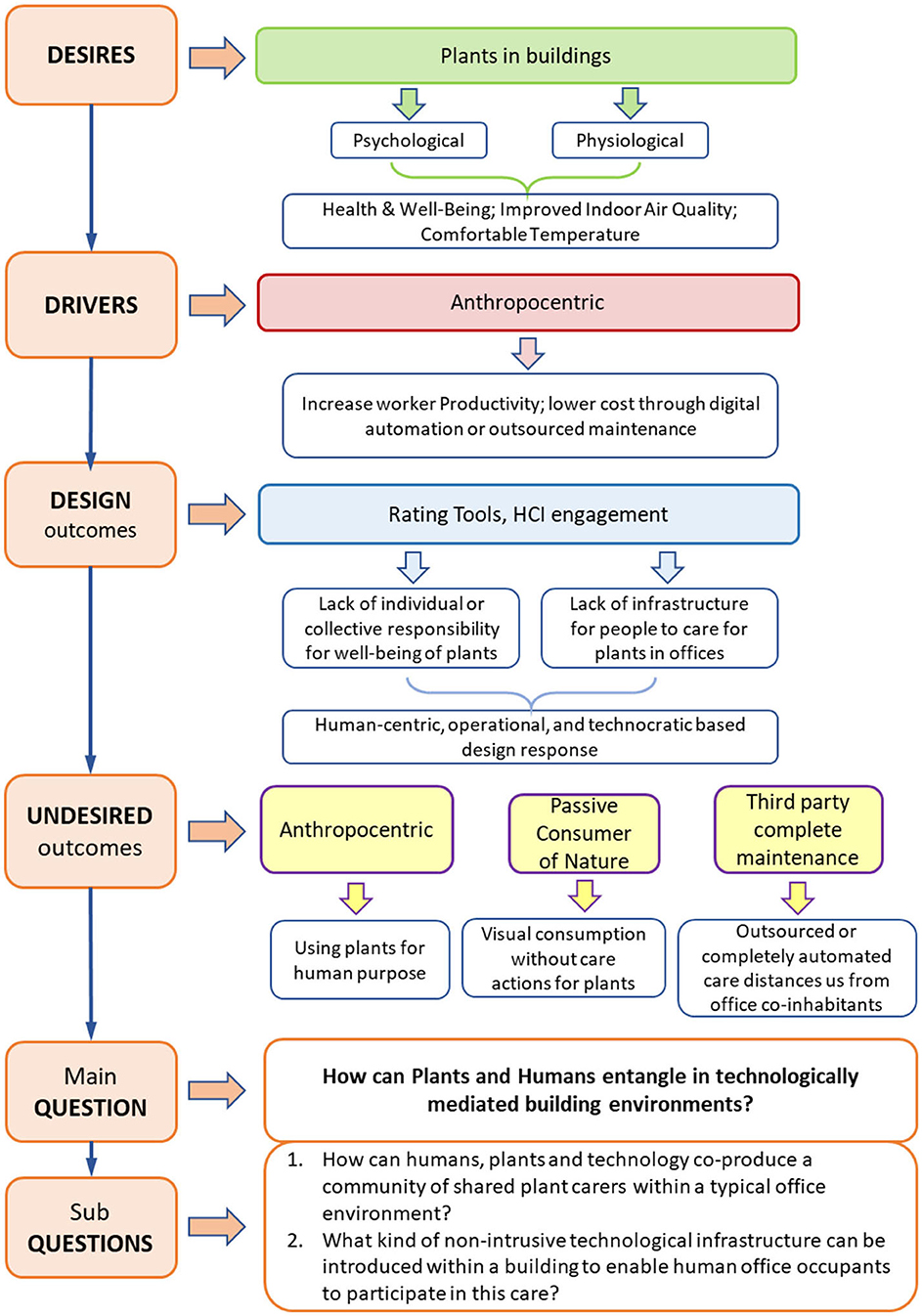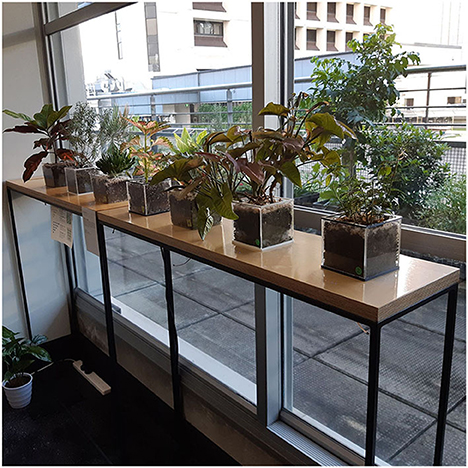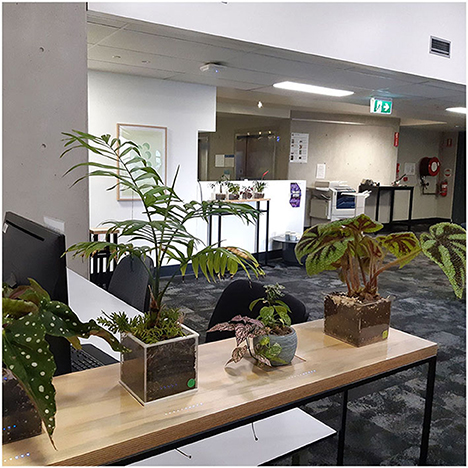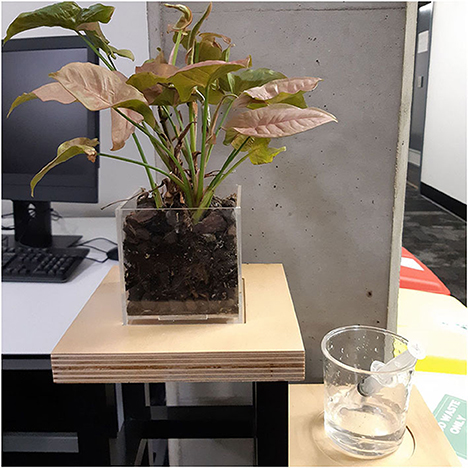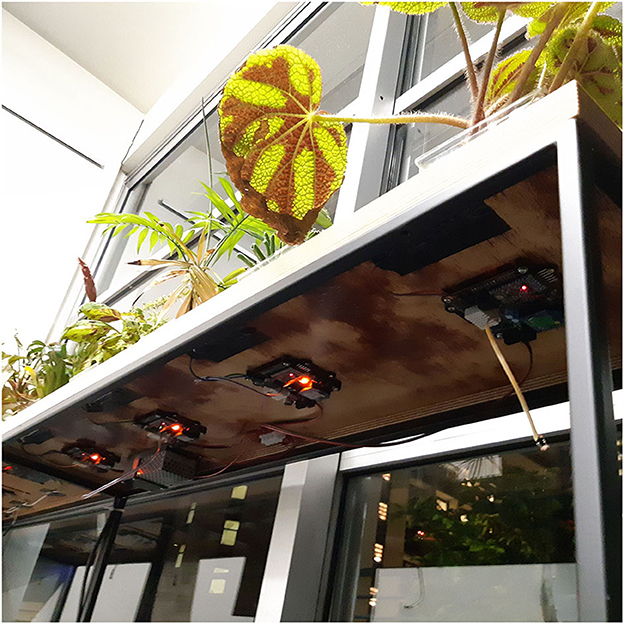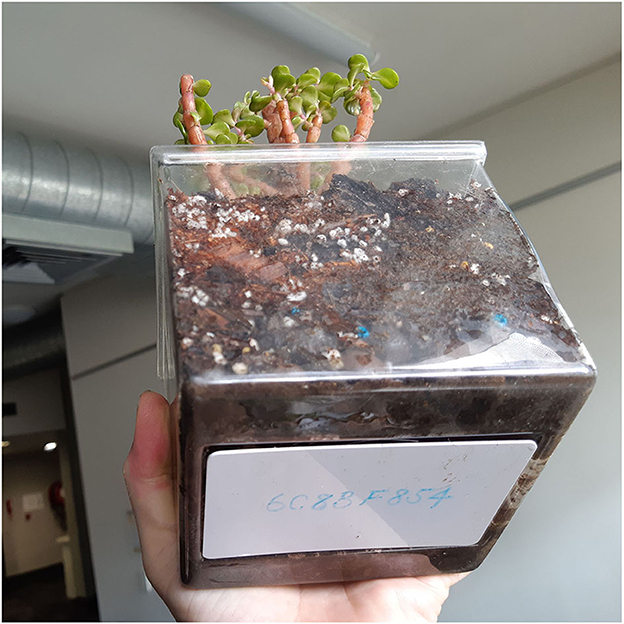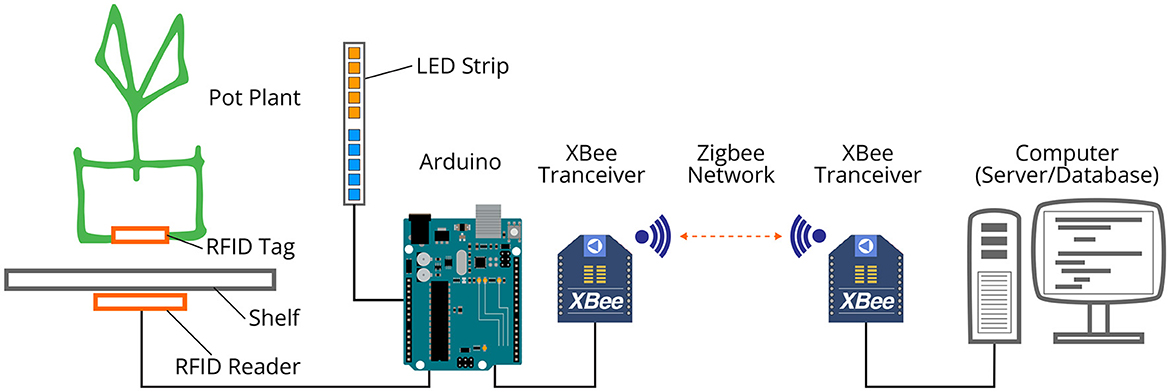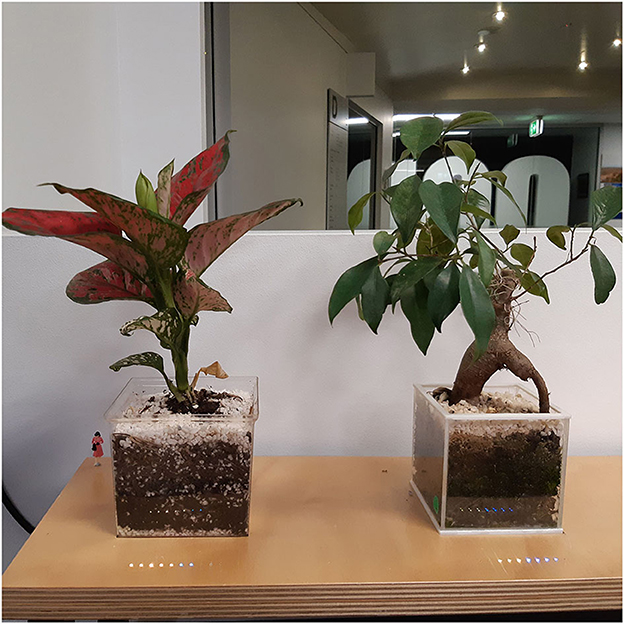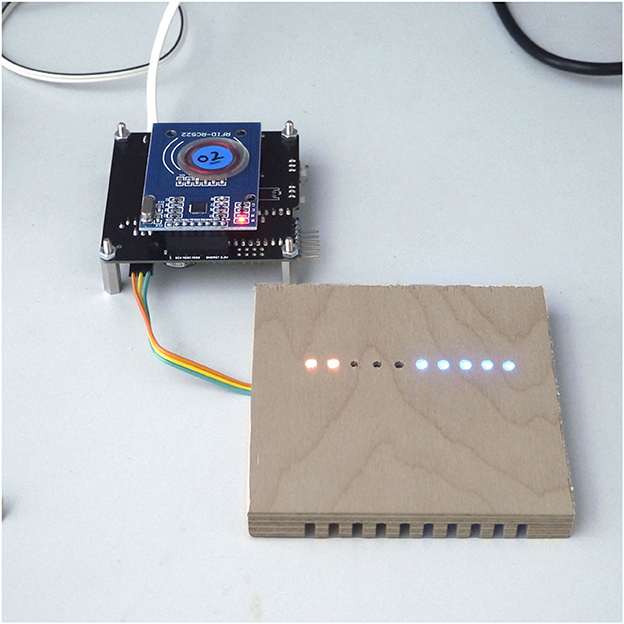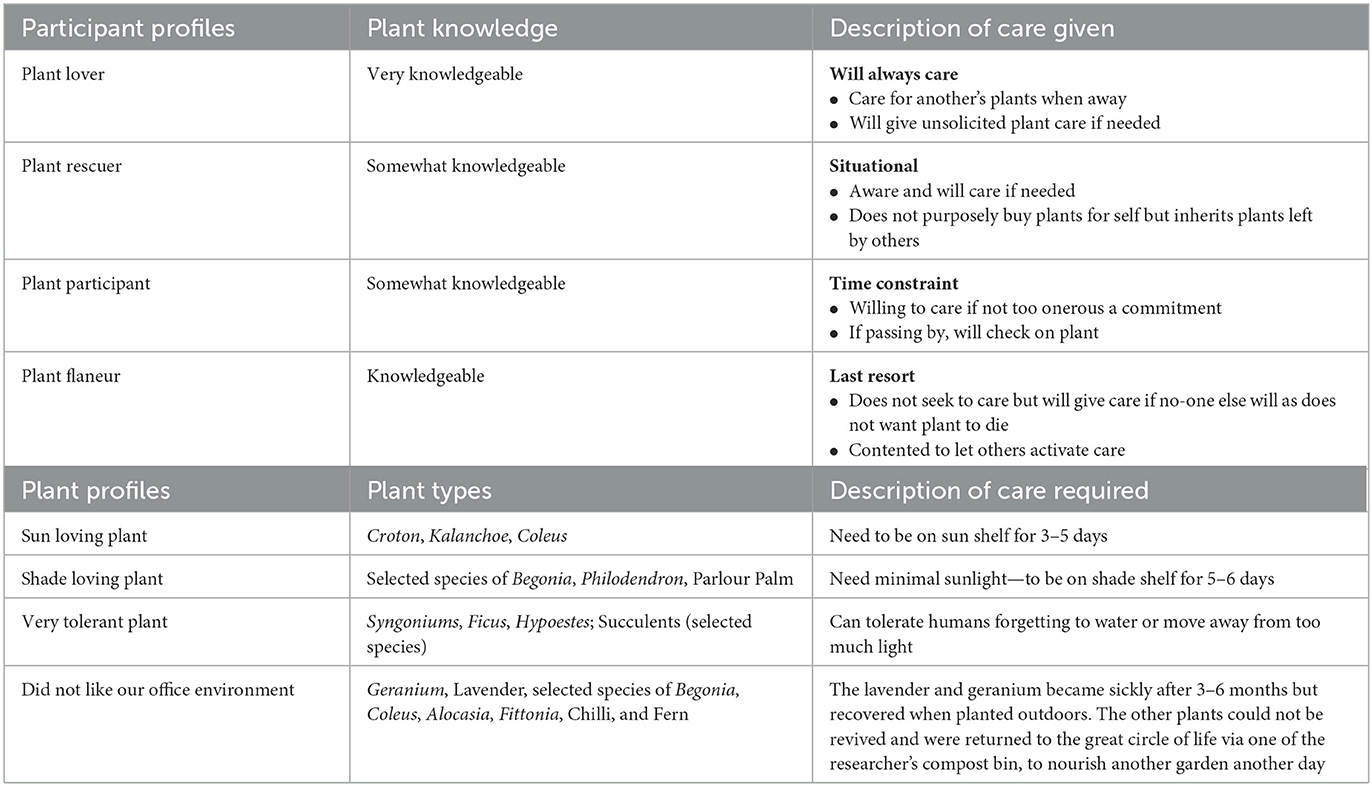- 1School of Architecture and Built Environment, Faculty of Engineering, Queensland University of Technology, Brisbane, QLD, Australia
- 2QUT Design Lab, School of Design, Queensland University of Technology, Brisbane, QLD, Australia
The current outsourcing of maintenance and the use of technological devices to automatically care for plants in buildings change the spatial experience between human office occupants and plants. This caretaker system distances people from plants, inclining us to regard them more as decorative objects. The relationship between humans and plants in a building is often unidirectional, with plants providing humans multiple benefits such as improved health and well-being, and increased worker productivity. In our human-plant interaction study, we developed a layer of care infrastructure within an office building that gives agency to people as a collective to interact with and take care of other non-human beings; that is, plants. In re-imagining mediated human-building interaction, we employed technology as an ambient mediator where people, plants and technology comprised the plant care system in a typical office building. A year-long design intervention was introduced within a typical office floor using artifacts (pots, shelves, and digital system) which we fabricated for the plants. From the results of an 8 week participation experiment together with data from qualitative interviews of 6 study participants, we identified five themes: Technology, Object/Thing, Infrastructuring, Commoning, and Care. Our analysis of these themes informs a care infrastructuring approach where both humans and plants become interdependent office co-inhabitants. By entangling with technology, care, and others, we present an infrastructuring layer to mediate human-building interactions with plants.
1. Introduction
Currently, there is a trend of greening buildings with real plants as part of sustainability efforts to increase energy savings and water efficiencies, and to improve air quality (Brilli et al., 2018). Increasingly, interior pot plants are included in office spaces as part of sustainable building actions in response to occupant biophilic desires (Hähn et al., 2020), to improve mental health (Dzhambov et al., 2021), and worker productivity (Nieuwenhuis et al., 2014). Emanating mainly from a human point of view, these benefits that plants give us, are often measured and valued in terms of points they can generate in some green building rating tools (Loh et al., 2020; Green Building Council of Australia, n.d.; WELL Certified, n.d.). Driven by an interest in challenging the human-centredness of plant-human interactions (Aspling et al., 2016; Sheikh et al., 2021), we set out to design and study plants as building co-occupants. This experiment sought to re-conceptualize a pot plant not just as an object giving us their one-way benefits but as a co-inhabitant of the office space we respectfully share with them. Realizing this goal requires a new approach to plant care beyond the outsourced maintenance arrangements that are typically employed in office buildings.
If interior pot plants are not brought into the office as a personal possession, then they are usually provided by building management and considered as physical assets of the workplace, simultaneously belonging to everyone and no-one. As a result, these plants are maintained by building management or more typically, the care is outsourced to a third-party service provider, which reduces the identity and perception of plants to mere decoration. Additionally, the use of plants in buildings could be a response to the biophilic preferences of clients or employees for a green indoor environment. At worst, this could be part of ecological branding contributing to just greenwashing (de Freitas Netto et al., 2020). Based on these observations and grounded in a more-than-human design perspective (Clarke et al., 2019; Akama et al., 2020; Giaccardi and Redström, 2020), we were interested in examining how to engage office occupants from being a passive consumer of “nature” to an active agent whose collective existence is crucial in the plants' local ecosystem.
Even if a building occupant were interested in taking care of the office plants, our typical office environments are never set up for looking after them collectively. Rostering can be a solution but the variable knowledge, interest and plant care capabilities of office occupants often make it unsustainable. From a building operational viewpoint, the approach of outsourcing plant maintenance premised on an economic model of efficiency is preferred to collectively caring for the plants. While viable, this top-down approach distances the building occupants from engaging with plants as their symbiotic partner. Informed by this observation, we commenced a design experiment where we gave simple technological enhancements to our office space, not just to make it easier or to motivate building occupants to look after office plants but to create an infrastructure and environment of care within a building that gives agency for them as a collective to act and take care of other non-human beings. We were interested in discovering how humans and plants entangle through technologically mediated environments within office buildings.
In this design experiment, we trialed different technologies to explore a new human-plant ecosystem in our built environment. We designed, fabricated, and tested physical artifacts such as pots, shelving and other artifacts suitable to integrate digital support systems. Considering plants are more than just part of the office furniture inventory or just movable or expendable items of the “Stuff Layer” as espoused by Brand (1995), we consciously designed from a non-exclusively human-centered point of view by framing our understanding of the pot plant as a relational (socio-material) network—in Actor-Network Theory terms—rather than an object that is inert (Latour, 2007). From our semi-structured interviews, we identified four patterns of behavior: Everyday, Choice, Knowing, and Collective Caring. In our analysis in Section 4, we discuss these patterns and examine why and how the participating office workers cared for the office plants using our experimental care infrastructure design.
In this design project, we designed a system for “co-shaping new entanglements” of care where both researchers and participants can “generate the conditions for care to flourish” (Light and Seravalli, 2019, p. 206) in an inclusive office environment where both humans and plants were interdependent office co-inhabitants. From this framework, our research developed an infrastructure to allow humans and plants to coexist in the office with a particular emphasis on the plant-human symbiotic relationship. Current scholarship in Human-Building Interaction (HBI) has focused on interactive and smart systems that deal with issues such as climate control or smart building interactions (Alavi et al., 2019). In our study, we sought to augment a building with a layer of infrastructure that introduces elements of care, which we then evaluated for its impact on improving both the quality of our built environment as well as our relationship with other humans and plants.
This paper is structured as follows. We describe our research experiment in Section 3, analyse our findings in Section 4, and in Section 5 we discuss the implications of designing an infrastructure to establish a plant-human ecosystem in an office environment instead of relegating plant care to outside plant maintenance providers. We preface the above sections with the following Section 2 where we provide a background to our experiment by briefly reviewing recent scholarship and plant-human interaction projects in design research that guided our study.
2. Related works
This section is organized into three areas that provide the background for our plant-human care infrastructuring project—(i) entangling with technology, (ii) entangling with others, and (iii) entangling with care.
While the notion of entanglement is used by various theories, here we focus on the contribution to human-computer interaction (HCI) scholarship by Frauenberger (2019) who argues that the evolving relationship between humans and digital technologies continues to challenge the foundations of HCI research and practice. In response to ontological uncertainties, epistemological diffusion, and ethical conundrums arising from new forms of human-machine coupling, Frauenberger suggests embracing performativity and acknowledging the agency of non-human actors (Sheikh et al., 2021). Plants as non-humans are largely still considered part of the material world (Fell et al., 2022). Hence, Frauenberger's (2019) call to consider the contribution of non-humans to the enactment of reality can help us trace accountabilities and shape moral deliberations about desired futures. This then also prompts a shift in design practices toward creating meaningful relations and new agonistic, participatory, and speculative design methods (e.g., Tomitsch et al., 2021). In this paper, we apply this idea of entanglement in HCI to investigate and understand plant-human-technology interactions within the built environment.
2.1. Entangling with technology
Our experiment primarily employed open-source software and hardware that anyone with a similar interest can implement in their own environment. The use of these readily available technological devices are already prevalent in many small-scale design projects at home, in the workplace, schools, or aged care facilities where pot plants are enhanced or augmented with LED lights, sounds, or movement, to encourage people to engage with them through various design strategies of persuasion (Fogg, 2009), affordances (Kaptelinin, 2014), and affective design (Picard, 2000).
Based on a more extensive literature review (Loh et al., 2023), we discovered that in the past 20 years, 72 papers published by the Association for Computing Machinery (ACM) discussed projects that specifically used technological devices to engage people with pot plants—for example, through tangible interactions (Adhitya et al., 2016), augmentations of plant qualities (Kawakami et al., 2010), and providing feedback via ambient interfaces (Kuribayashi and Wakita, 2006). In our design project, we employed these types of digital technologies and design strategies to create an infrastructure to enable building occupants to interact and take care of the office pot plants while being mindful of Wakkary's (2021) note that “technologies and humans need to be viewed together as a meaningful whole rather than separately” (p. 6) because “human entanglement with technology is a mutual becoming, in which humans and technologies influence what each other becomes” (p. 101).
2.2. Entangling with others
The availability of accessible DIY technology and networked devices to assist with the care of indoor plants has opened up opportunities to take care of a plant collectively with others within a community such as growing food within an office environment (Farr-Wharton, 2019); networking a communal plant watering system where residents could care for plants with others in an apartment block (McDonald, 2018); or Plant Hotels (Wu and Koskinen, 2022). Crosby and Vanni (2022) entangled the public with plants and seeds to activate new alliances and understanding. These studies produced evidence that people are more willing to participate in the care of indoor and outdoor plants when being part of a community.
In the recent COVID lockdowns, the security team of a UK office building took their own initiative to care for all the abandoned pot plants across 12 floors of offices, much to the surprise of the plant owners when they returned back from lockdown (Bakar, 2020). The unsolicited provision of care by others within an office reveals the shared sense of being part of a community where care is willingly enacted for others.
2.3. Entangling with care
When caring for others or for the office pot plant, one is not just concerned for caring about them, but one is actively taking care of the plant and engaging with it to understand its needs. “Caring involves a notion of doing and intervening” (Puig de la Bellacasa, 2011, p. 89). It is this relational thinking that brings about the active carer instead of passive consumer of “nature” in our office pot plant experiment. In relational ethics, “attentiveness and responsiveness to our commitments to one another, to the earth, and to all living things” is demanded over “resolving ethical dilemmas through good moral reasoning” (Given, 2012, p. 750). By engaging with others in the co-production of care, we not only entangle ourselves with the plants and others in the community, we also revert back to how for example, Australian Indigenous peoples have lived in harmony with nature for millennia (Graham, 2014; Graham and Maloney, 2019). When we “decentre the human as the sole source of activity and…elevate the role of the non-human world from a passive backdrop to human activity…[they become] active contributors to relational action as it unfolds” (Frauenberger, 2019, p. 2:21).
We do not see the act of caring as just a benign act of watering the plants but akin to what Haraway describes as the co-transformation through the care relationship with her dog. “Care is not one way; the cared for co-forms the carer too” (Puig de la Bellacasa, 2017, p. 219). Sustaining a co-existence of human and non-human plant requires active caring, and through the care infrastructuring we designed for our plant-human engagement, we wanted to co-create this relationship with our fellow office occupants, both our human colleagues and the non-human pot plants sharing the same office space. In our project, we realized that relying on voluntary kindness or top-down instructions was not enough to introduce the environment in which humans and plants can entangle. Thus, we began exploring opportunities to augment our office spaces with a technological layer. We now turn to introducing our study's design approach.
3. Methodology
A cost-cutting exercise enacted by our university's building management a few years ago, meant that they no longer provided or maintained the indoor plants in our commonly shared office spaces. We took this opportunity to propose an experimental design intervention to inquire if we as building occupants can take care of the indoor office plants ourselves as a community instead of outsourcing their maintenance to a third-party service provider.
We were interested to know how human occupants would interact with the unassuming interior office pot plants if some basic technology was added to assist the office occupant to take care of them. Our guiding research questions were: (i) How can humans, plants and technology co-produce a community of shared plant carers within a typical office environment? (ii) Consequently, what kind of non-intrusive technological infrastructure can be introduced within a building to enable human office occupants to participate in this care? These two research questions have been informed by our earlier research analyzing the implications of using plants in technologically mediated environments (Loh et al., 2023). Together with the background identified in Section 2 Related Works, we contend that the human desire to enjoy plants in buildings is predominantly anthropocentrically driven. This tendency, in turn, translates to design responses that are usually human-centric, operational, and technocratic-based. The undesired outcomes out of this trajectory contributes to using plants solely for human purpose, encouraging the building occupant to be a passive consumer of nature, and delegating care to third-party maintenance which distances us from plants. From these observations and research, we formulate our theoretical framework (summarized in Figure 1) to investigate how plants and humans can entangle in technologically mediated building environments. Our two sub-questions which are noted above, ensue from this theoretical framing (see Figure 1).
This research created artifacts for participants to engage with, but it is not about the making of a cultural probe to find out how people interact with indoor plants. It is also not about facilitating a user study on how people take care of indoor office plants. Although the design experiment used some methods similar to action research, it is also not an action or participatory action research project. The work in designing and fabricating the artifacts was not focused on designing a solution to the issues raised. Instead in our research, we conducted an experimental study to discover how humans and plants entangle in a typical office environment to open an understanding from a less anthropocentric viewpoint. The experiment carried out a “process of iteratively designing artifacts as a creative way of investigating what a potential future might be” (Zimmerman et al., 2010, p. 313). Brandt and Binder (2007, p. 13) make a slight distinction between interventions and experiments, namely “to make the distinction between the experiment as an activity of the researcher and the intervention as the way the research can be observed to intervene (interact) with the subject matter”. In this research, the experiment is also a design intervention because the artifacts (pots, shelves, plants, and digital system) did not exist before, nor were they employed in any office circumstance. The design intervention made available a new and different encounter with indoor plants and invited participation/engagement with them. Additionally, Brandt and Binder (2007, p. 13) themselves clarified as well “that any experiment, which is worth considering as a contribution to research inquiries, must somehow involve an intervention with the world.”
The main and two subsequent research questions (identified in the previous paragraph) were used to investigate how people and plants can co-exist within our shared office space. The findings contributed to awareness of issues not considered before the start of the design experiment and will contribute to future design actions. By developing/creating a way which is different to the way we have always been doing things means/indicates “design is always already political. Design is intervention. It changes experiences, situations, practices, and beyond” (Lindtner et al., 2018, p. 109).
This research investigated human engagement with plants within a building space using methods such as designing of artifacts, observing plant welfare, care actions taken by participants, and obtaining data through interviews. The knowledge obtained via these methods enabled the building of theory through reflection of the research actions.
In our design intervention, we viewed technology as an ambient mediator where humans, plants and technology comprised the constructed (fabricated infrastructure) and biological (people and plants) ecosystem in the office, and were composed of: (i) artifacts such as pots, shelves, and digital components, (ii) biological media such as potting soil, sunlight, water and plant nutrients, (iii) humans, and (iv) non-human species which were the plants. The design intervention provided three basic conditions to assist different plants to thrive (sun, rest, and water) in an office setting. Hence, we placed shelves in different locations to support these basic needs because our office building, like most other ones with similar space limitations, is unable to provide all three conditions in one convenient location. We illustrate this in schematic form in Figure 2 showing conditions for (i) sun, (ii) rest, and (iii) water.
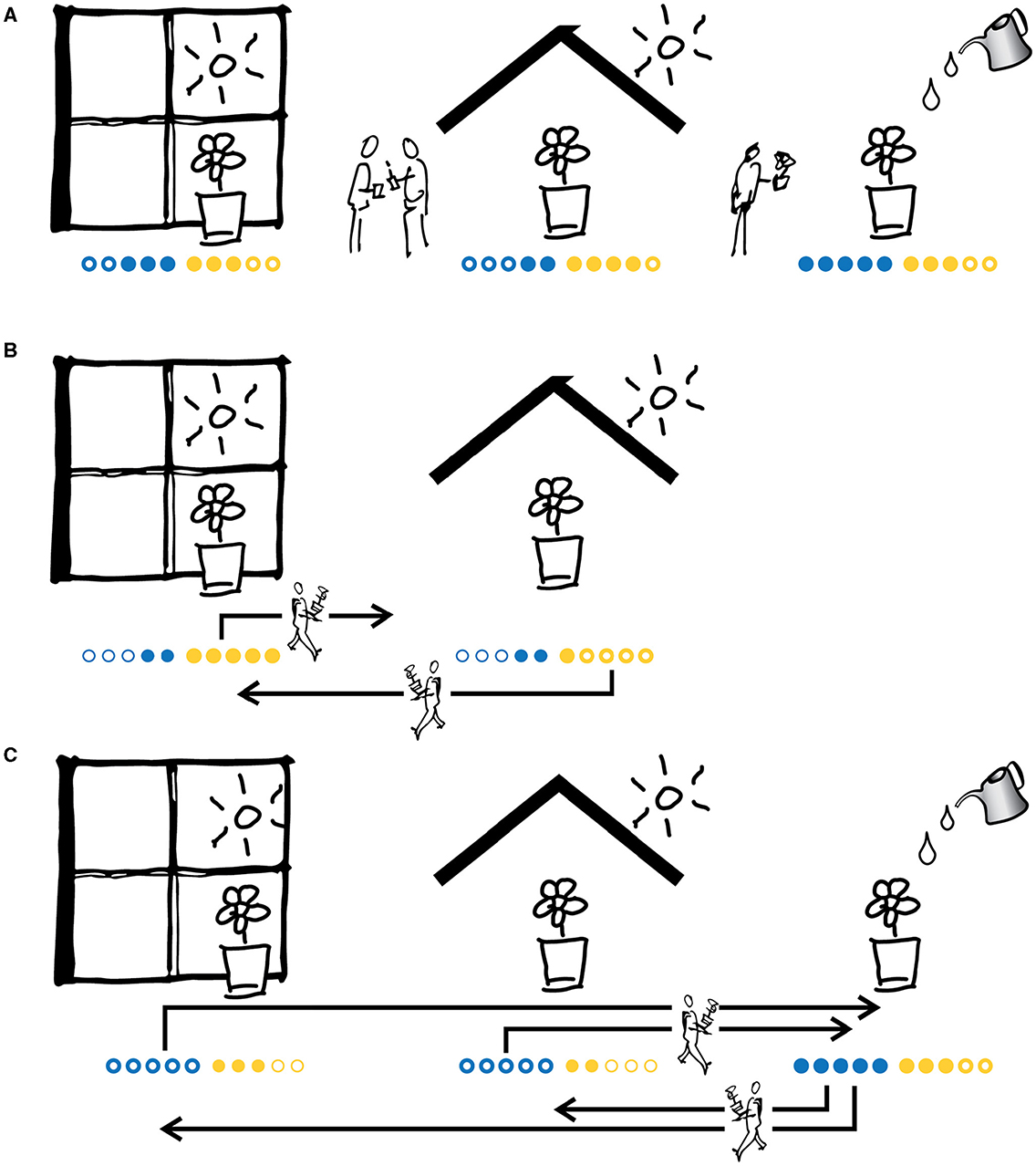
Figure 2. Schematic of plant care system.
(A) Showing SUN, REST, and WATER requirements.
(B) Moving pots from SUN shelf to REST shelf. And vice versa.
 enough sun, move pot to REST shelf
enough sun, move pot to REST shelf  not enough sun, move pot to SUN shelf.
not enough sun, move pot to SUN shelf.
(C) Moving pots from SUN and REST shelves to WATER station and back.
 plant needs water
plant needs water  plant is watered—return pot to either SUN or REST shelf.
plant is watered—return pot to either SUN or REST shelf.
Figures 2A–C describe our plant care system in simplified schematic format. It is introduced here to give an overview of the basics of the experimental procedure. In the following Section 3.1, we describe in more detail, how our proposed technological infrastructure works, accompanied by photos of the actual set-up where human participants can care for the plants with this system (Figures 3–6).
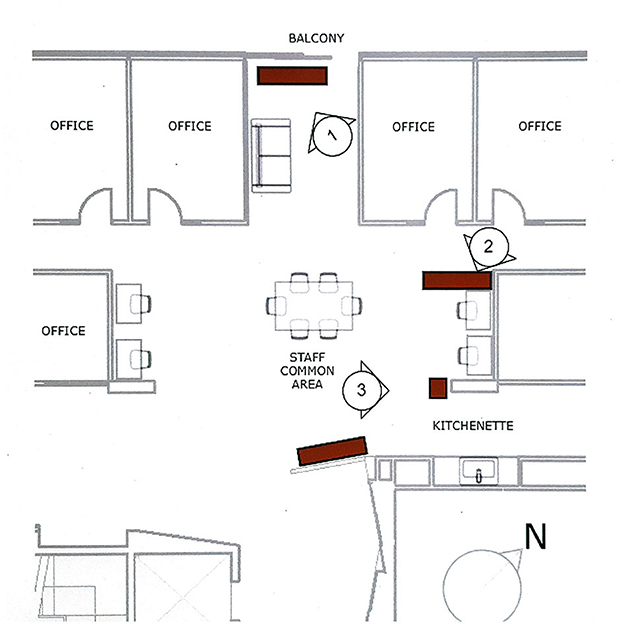
Figure 3. The plan in this figure identifies the location of Views 1 to 3 to correspond with Figures 4–6. The North facing window identified as View 1 in this plan (Figure 4) is in the Southern hemisphere.
In the following section, we first describe this system within the physical context of the design intervention (i.e., our office space) and the plant care protocol for humans in Section 3.1. We then describe humans and plants as participants in Section 3.2.
3.1. Design of the plant care system
Not too different from humans, plants require access to some basic life necessities such as light, water, air, and nutrients. Indoor office spaces can only provide plants limited access to these basic life necessities. For example, many office buildings only offer limited window spaces for potted plants to reside at, thus limiting their access to sunlight. Office spaces are designed also to ensure water does not enter indoor spaces, and we therefore need to ensure plants are watered. With these limitations in mind, the common area of our office floor was chosen for our study, because it is the main communal space for the existing office occupants/potential plant carers who gather for their shared meals, to make coffee, or for informal meetings. Here, we chose four locations for the plant shelves (Figure 3) so that the human occupants can easily see and access them. The first shelf location was chosen due to its proximity to a sunlit window (sun shelves). Because there was only one window in the common area, two other shelf locations were chosen in not-so-sunny but highly accessible and visible positions (shade/rest shelves). One additional shelf was placed next to the kitchen sink for easy access to water (water station) (Figures 4–6).
While the positioning of shelves is important, it is critical to consider how office occupants can be made aware of the plants and to participate in becoming their carers. We have chosen to develop some notification systems for the office occupant passing by, to easily understand what and when they need to activate some simple caring actions.
In the marketplace, one can purchase readily available technical parts such as light and humidity sensors, solenoids, small submersible pumps, timers, etc. to make a fully automated plant watering system. One can also develop a system to remind people to water or move plants by attaching moisture or light sensors to the pot to measure the moisture in the soil or amount of available light. This information can be communicated to humans in the plant's proximity via a LED or screen interface, or to everyone via network devices like a smartphone. The main goal of these projects was to communicate or broadcast plant information by embedding technologies in pots to directly monitor the plants' condition. We took a slightly different approach.
The priority we set was to introduce a physical and technological care infrastructure where both office occupants and plants simply exist in situ, and to establish a symbiotic relationship in an impromptu manner, just like a bee's incidental encounter with a flower. The technological layer should be just enough to notify humans of the plants' conditions and allow them to take simple care actions accordingly. It was also essential that with our designed system, we could easily scale up the care infrastructure without much technological oversight and would be simple enough for anyone to make additional contributions, such as bringing their own potted plants. For this project, we made our own pots to ensure they can be easily identified without any confusion, but it could have been any other pots that people choose to add to our care infrastructure as long as it has a flat base to which a small Radio Frequency Identification (RFID) tag can be attached.
The intention was to make this care infrastructure scalable and more inclusive. By asking the human occupants to move plants to their desired locations, they could become an integral part of this infrastructure. Thus, we embedded all technologies under the shelves rather than in each pot (Figure 7). This decision was crucial to ensure that the pots were free of any technologies that required maintenance, fixing or replacement in order to reduce the maintenance cost and time and to allow the community to more freely add or replace pots without the need to deal with installing devices or technological consequences—other than to add an RFID tag and adding plant information to the database that informed us of each individual plant's needs. This approach allowed anyone interested in bringing in their own favorite potted plants to be added to the system (Figure 8). We explain the technologies below in more detail.
The purpose of the technological layer was to notify humans whether each plant needed more light or water. When the pot was placed on one of the marked spots on a shelf, the RFID reader read the RFID tag attached to the bottom of the pot. The microcontroller (Arduino) received and processed the ID unique to each plant and sent it to the server over the Zigbee wireless network, and the server recorded in the database the time the pot was placed on the shelf. The server then retrieved the plant information from the database that maintained the record of when each pot was placed on or removed from which shelf and returned the total duration the pot had been on to the shelf unit that originally sent the ID. In essence, the server maintained a record of how long each plant had been on the sun shelves (receiving sunlight), the water station (given water), and the rest shelves (no extra light or water received). If the pot was not placed on any of the shelves, the system was not able to locate its whereabouts, but it assumed the plant did not receive sunlight or water until it was placed on a shelf (Figure 9).
When the data returned by the server was received by the shelf-unit, its Arduino processed the information to determine the number of orange and blue LEDs (up to 5 each) to turn on. The orange LEDs indicated the amount of sunlight the plant has received, and the blue LEDs indicated the amount of water it had received. Because the pots did not have embedded sensors, the amount of sunlight and water they received were estimated from the information kept by the database about how long each pot was placed on shelves with particular attributes (i.e., sun, water or rest shelves). When the pot had been on the sun shelf for a predefined period, which was determined by the plant's specific needs, all five orange LEDs turned on. If the duration exceeded the predefined time, the last (5th) orange LED blinked to indicate the plant had been under the sun for too long. If it was brought to the water station, the system assumed the water was given by the person who placed it, and all five blue LEDs turned on. With each predefined period passing without sun or water (again, determined by each plant's needs), the number of orange (or blue) LEDs reduced incrementally until only one was on, followed by the last remaining LED blinking to indicate it required sun or water. It was not an automation system. It required a little help from people to satisfy its needs (Figures 10, 11).
The role of the building occupants was to recognize the LED status and respond with appropriate action because there was no third-party vendor responsible for the plants. They were typically informed through the blinking LEDs and invited to take action by moving the pot to a sun shelf, a resting shelf, or the water station to give water whenever they can (refer to Figure 2 introduced earlier).
As mentioned above, each plant had “predefined periods” that defined how frequently it should receive sunlight and water, and the numbers were kept in the database. The predefined periods were determined by initially using commonly understood gardening requirements for the plant's needs and then we adjusted the numbers until the plant was doing well in the environment. Predictably, some plants became less healthy over time despite our effort with the system and required additional care from the plant doctor (the lead author). Most plants lived well beyond our expectations, but some we found did not thrive in the office environment and had to be returned to their original home.
Our design intention was to focus on the plants and the humans interacting with them in their environment, through a technological layer that informed them when the plants needed water or sunlight. The plant's welfare was entwined with its pot, humans, and the technological systems. Humans are a critical life necessity for our office plants, and plants are crucial co-occupants for reasons discussed earlier. In the next section, we discuss the implications of this symbiotic system of plants, humans, and technology which we deployed in our office for over 1 year through observations and interviews with our human study participants during this period.
3.2. Human and more-than-human plant care participation
Six office occupants (fellow design academics) who resided in the offices of the building volunteered to participate and care for the pot plants in the common area for a period of 8 weeks, and they were briefed on how to read the LED signals in order to move the pots from a sunny to shady spot or vice versa, and also how to water the plants.
Two (20–50 min) semi-structured interviews were conducted to obtain feedback from the participants, at the start and end of the 8-week participation period, that is, a total of 12 interviews. At the first interview, initial instructions were given about how the system worked which were then followed by preliminary questions to establish a baseline understanding of the participant's plant caring knowledge, office plant experiences, and level of interest to engage with shared plant caring within the office. For the exit interview, participants gave feedback on what they did, what they thought about the whole process, and suggestions for what worked, what did not, and what other things they thought might work better in order to take better care of the plants.
A sample of the interview questionnaire is included in the Appendix A. The questions in Appendix A are an indicative list as slight variations occurred depending on the interviewee's responses which sometimes required follow-up questions or further clarification. This method of interviewing aligns with the qualitative nature of this research where our physical design intervention is investigated further through technological means, visual observations, verbal interviews, and data analysis. Our 12 data points (6 × 2 interviews) may be construed as a small sample size, however, we consider it appropriate to our study as “sample size alone is not the only factor at play” (Braun and Clarke, 2021, p. 211). We were interested in getting rich data, “getting different stories” to understand the outcomes as we believe that “meaning is generated through interpretation of, not excavated from, data…” (Braun and Clarke, 2021, p. 201). Using simplified coding methods from thematic analysis, we condensed and distilled interview data to find links, correlations, or emergent themes, following established qualitative analytical methods as “concepts and categories are also a means of establishing relations…between different entities” (Lazar et al., 2017, p. 304). The small sample size enabled us to more deeply research “the material within a spiral of conceptual development rather than across a plane of data” to produce findings that “indicate rather than conclude” (Crouch and McKenzie, 2006, p. 491).
The interviews were recorded, transcribed, and the content analyzed qualitatively to identify the main recurring themes and patterns from the plant carer's experiences. These personal narratives provided insights to understanding the implications of constructing an alternative perspective to the caring of and interacting with office plants. Although we sought responses concerning the care protocol and prototypes, we interviewed the participants not as “test subjects” to a design experiment but considered them as active co-constructors of an evolving plant-human relationship through a newly introduced system of office plant care.
The study participants in our design intervention were the six human co-workers inhabiting the office floor and the 16 non-human plants selected to grow in the individual pots. There were three male and three female participants ranging from 30 to 70 years of age who were full-time teaching/research academics in design with individual offices in the faculty building on campus. Four of the six participants have a good to a high level of familiarity with interactive technologies while the other two have a general working understanding. The characteristics of both plant and human participants are further described in Table 1 where human participants were given the choice to take part in our study while the plants did not have a say in being chosen as participants. However, we endeavored to find out how to enable our plant participants to grow well in our environment in seeking this alternative form of caregiving by the community of office occupants.
The plants in our study were given autonomy to flourish, and humans were the support system for them through the digital infrastructure of our designed technological layer. Human participants enabled the office plant ecosystem required for the plants' survival by caring for them, giving them enough sunlight, water, and nutrients to live well. Kallhoff et al. (2018, p. 110) view care as an ecological virtue where the stronger notion of caring for as opposed to caring about indicates not only “a committed relation of holding somebody/something dear, but also the practical engagement of protecting, helping, fostering the other, of promoting the other's good.” Humans provided the office plant ecosystem for plants to survive indoors to enable them to co-exist with us for mutual benefit.
4. Analysis of results
In this section we describe the outcomes of our experiment by discussing our findings from the human participant/plant carer's perspective and extrapolate from the plant's point-of-view. We summarize some recurring patterns from our interviews with our human participants to inform our discussion in Section 5.
4.1. Plant carer and plant profiles
From the analysis of the data collected from the interviews, we created a Human-Plant Carer Profile and also a Plant Participant Profile to describe the different characteristics of the human and plant participants (Table 2). The characterization is developed with a broad stroke as it is meant to provide a frame to introduce and discuss the emerging patterns of behavior in Section 4.2.
Table 2 describes the breakdown of 6 participants as:
• 1 plant lover.
• 1 plant rescuer.
• 3 plant participants.
• 1 plant flaneur.
This shows willingness of a majority of participants to take care of the plants if the commitment is not onerous. Through the design of the care system with unobtrusive ambient notification and caring tasks simplified through the technological layer, we discovered that it was responded to by participants whom we think could be our main target audience. This, however, does not mean that the other participant characteristics are to be ignored. From initial observations, we believe that the mix of characteristics is essential for the care infrastructural ecosystem to work—which is closer to a representative of an office setting.
4.2. Human interview findings—Emerging patterns of behavior
Coupled with the physical intervention, we were interested in finding out how office occupants responded to the design intervention. We analyzed this qualitative data thematically to identify four groups of recurring patterns from the participant interviews. Firstly, the interview text was distilled into meaningful clusters by condensing descriptive whole paragraphs into shorter sentences to understand the underlying meanings. Secondly, this information was then organized into thematic clusters by identifying recurring concepts through repeated reading to ensure the essence of the information given by the participant was preserved. The intention was to use simplified coding methods espoused by proponents of this type of thematic analysis (Vaismoradi et al., 2016; Braun et al., 2019) to suit our small design intervention and identify emerging areas of concern for future research. Table 3 shows a sample matrix of how we extracted the emerging themes to understand how participants responded to the design intervention. This list was refined with repeated reading to establish succinct and relevant themes.
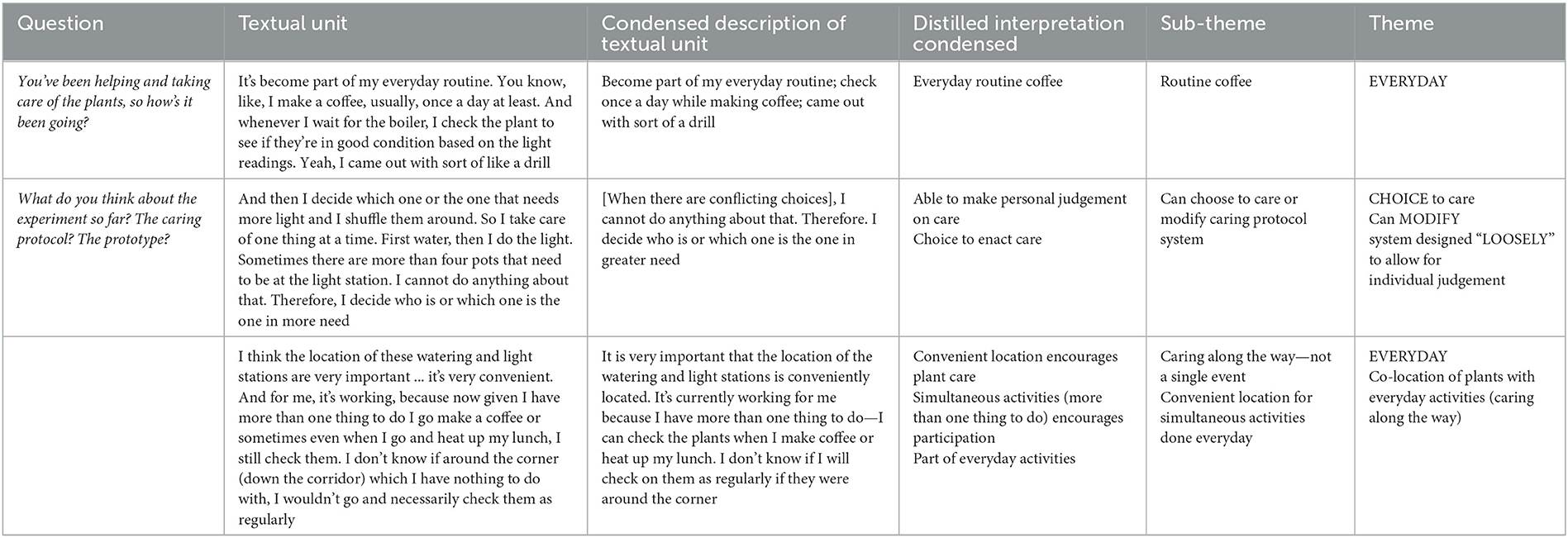
Table 3. Data sample to exemplify how the empirical data from this design intervention was analyzed in order to identify emerging themes.
In the following subsections below, we expand on the four recurring themes we distilled from our analysis; that is, of Everyday, Simple System, System with Choice, and Individual and Collective caring and knowing.
4.2.1. Everyday
If the infrastructure of a plant care system is integrated into the dynamics of everyday life inside the building, it can become a daily routine. Together with an intuitive and easy-to-use interface, locating the plants close to where these daily activities are performed, enabled everyday practices to be entwined with the welfare of the plants. In order to empathize with the plant's health, humans need to see how it is doing that day, akin to catching up with a friend and finding out how they are going.
Participant 1 (P1): “It's become part of my everyday routine…I make coffee once a day at least and whenever I wait for the [water to] boil, I check the plant to see if they're in good condition based on the light readings. I came out with sort [sic] of a drill…I think the location of these watering and light stations is very important…it's very convenient.”
P5: “The way that the system is integrated in the dynamics of everyday life inside the building, I find fascinating.”
4.2.2. Simple system
The system is designed for easy participation that requires just a small amount of effort to respond to the light indicators to either water the plant at the water station or move the plant in or out of the sun. The time taken for this action can range from less than a minute to no more than 5 min but requires observation and empathy to want to offer care to the immobile pot plant.
P2: “The plant care is heavily scaffolded by the indicator, remov[ing] the indicator will become way too much work…you don't need to know who's doing what. You just need to know what's on the information.”
P3: “[I want] just an informal arrangement…don't think you need to complicate these things…if it looks like it needs a bit of water, then you just give it some water.”
A system which is designed “loosely” with technology; that is, just through ambient light notifications, encourages a person to be in a closer relationship with the plant as the technology remains in the background. This way, they do not feel burdened with the task of plant caring.
4.2.3. System with choice
It is important for people to feel they have the personal choice to care—not bound by a dedicated roster, constant social media reminders, or feel guilty for letting colleagues or plants down.
P1: “And then I decide which one or the one that needs more light, then I like shuffle [sic] them around. So, I take care of one thing at a time. First water, then I do the light, sometimes there are like more than four pots that need to be at the light station. I cannot do anything about that. Therefore, I decide who is or which one is the one in more need.”
The system does not try to relegate caregivers to mechanical “extensions” of the system itself. It is designed so that building occupants remain in charge and maintain responsibility and agency. Caregivers are free to choose to care for the plants and also exercise their agency and personal judgement in interpreting the gradient of five blue and orange lights—for example, the carer may view two blue lights as dry enough to start giving water depending on how sad the plant looks. The digital information is thus coupled with the decision to enable a participatory interaction—the building occupant is more entwined with the care of the plant by making care decisions based on information about the plant's state provided by the system.
4.2.4. Individual and collective caring and knowing
The system does not identify any individual giving the care but collectively the community knows—even though they may not physically meet each other—that care has been administered when they see the plants flourish. The activity of taking care of the plants also offered an opportunity to socialize with others in the office and not feel that they were alone in administering plant care.
P2: “that's a good sort of—you know—social collaborative activity which I think that could be even like something [sic] that you can do with your colleagues.”
P4: “I do it first thing in the morning. But sometimes [P1] and [P5] does it when I've come late.”
Indirectly knowing the success of their combined care in the form of a healthy plant, can help to cultivate a community of plant carers.
5. Discussion
The augmentation of the pot plant with technology afforded a different type of relationship between humans and the plants, which in turn, created new scenarios in the everyday lives of the participants within the space. From the findings and interview data, we distilled four key recurring patterns in Section 4, which we now discuss in more detail by focussing on five main themes of: technology, object/thing, commoning, infrastructuring, and care. Based on the experience of running our design experiment, we found these aspects to be pertinent to the establishment of the symbiotic relationship between plants and humans. It also informs the basic framework of any potential HCI interaction between people with their built environment.
5.1. Technology
Usually when technology is added to the function of an object or service, it is meant to decrease the workload of the worker through increased automation. In our project, we purposely designed our plant caring system to be simple, ambient, and neither automated nor aimed at creating efficiencies or optimisations (Powell, 2021). The intention was to give people an opportunity to directly connect with and care for the plant with just enough digital assistance so as to allow them to maintain agency, thereby being active co-constitutive partners of the plant care system.
The ambient LED light notifications were meant to be unobtrusive, giving participants the choice to act on them or to ignore them. No gamification inducements or repeated phone messaging were employed to entice the participant to enact care for the plant to avoid relegating plants to utilitarian objects by using them as proxies for nature, interfaces for experiences or triggers for actions (Loh et al., 2023). The system was not complicated to use in order to be inclusive and enable participation by anyone. It was also designed so that participants were given the latent ability to exercise their own judgement whether to override the system notification for better care (see Section 4.2.3 where a participant made a personal judgement on the care of the plants when there were conflicting choices given by the digital system). We consider this overriding of our digital system to be a success as we want participants to be an active part of the caring protocol—to notice the plants' welfare, use their knowledge to respond to their needs with the help of the light indicators and thus assisting the plant to thrive.
In discussing the changing framework from machine-centered computing to human-centered computing, Tedre pointed out that we should be asking, “what should be automated” instead of asking “what can be efficiently automated” (Tedre, 2008, p. 48). However, we suggest moving the frame from human-centered efficiency to a plant-inclusive environment to ask, “how much do we automate?” We advocate a simple system where humans and technology can co-produce appropriate care for the living “beings” in the office. More automation or outsourced plant care could distance us from understanding plant needs and serve to homogenize plant care as is currently evidenced in ubiquitous indoor plant species seen in any office around the world irrespective of culture or climate.
By augmenting the pot plant with a simple LED light system to indicate water/sun care requirements, our design does not just address the practical requirements of the plant—it changes our relationship with the plant. Verbeek points out, “the relation between humans and technologies is in fact part of a larger relation, between human beings and their world, in which technologies play a mediating role. What is being designed, then, is not a thing but a human world relation in which practices and experiences take shape” (Verbeek, 2015, p. 28).
5.2. Object/thing
Highlighting the plant-human-technology relationship discussed above, the distinction between object and thing assisted us to frame the way we designed care for our office pot plants. An object is viewed as a non-living, non-connected entity existing within a closed loop system while a thing is understood as an assemblage of concerns constituting an open system. In this sense, we borrow from Heidegger (1975) and Latour (2005), that every thing is connected and related to each other, in that “[t]hings are not cut off from human relations, but rather are socio-material “collectives of humans and non-humans” through which “matters of concern” or controversies are handled” (Bannon and Ehn, 2013, p. 57). Thus, by viewing plants as interconnected with our daily practices within our sphere of concern, we made deliberate design choices to the fabrication of our pot plants and shelf: (i) The pot was purposely designed to be transparent to focus our attention away from the pot so that we can see the messiness of the soil and be made aware that the plant is not a decorative object but a living organism—an alive other, and (ii) The shelf was built to waist-height so that plants were closer to eye-level to help us connect with them on par. Additionally, by co-locating them as part of social spaces such as coffee making facilities, we also entwine them with our everyday lives where caring for them becomes part of our daily routine.
Some plants had to be removed and replaced as they were starting to do poorly and succumbing to disease. However, this was noticed by some participants who inquired during their interviews why certain plants were missing. We viewed this as affirmation of people interested in the pot plant as a thing and more than just an object. The pot plant is now an assemblage of plant concerns and human participation, manifesting Latour's (2000, p. 10) comment that “[t]hings do not exist without being full of people.”
5.3. Infrastructuring
Our concept of infrastructuring is related to but different conceptually to Brand's (2018) Infrastructure layer, which is seen as a large type of system—such as education, science or water in the natural landscape—that is used to support the functioning of other layers. Here we expand this concept to infrastructuring. Infrastructure is usually viewed as a complex interrelated system that is not normally made visible—for example, below ground service systems for a city or IT networked support systems for a large organization. A shift in the understanding of infrastructure commenced in the 1990s when Star suggested that infrastructure was “both relational and ecological” and inseparable from the context, in that it is always an assemblage, a complex weaving together of many tasks, resources, politics, etc. (Star, 1999, p. 377).
Infrastructuring soon began to be used in design research to denote “situated practices that connect everyday local practices with the larger, often global technological systems” (Bossen et al., 2014, p. 221). Any artifact, object or system that is designed to be deployed within a community is unlikely to be designed successfully as stand-alone but is one that is “co-constructed with the sociotechnical systems that artifacts get adopted into” (Wong et al., 2020, p. 10)—be it digital or botanical. Thus, the success of sustaining the wellbeing of our pot plants is entangled with the desires and actions of the office occupants. The technology we designed to support plant care in the office was not infrastructure that acted as “a substrate for other actions…to run on top of, but rather an ongoing alignment between contexts” as suggested in Ruhleder and Star (as quoted in Björgvinsson et al., 2010, p. 43). We consciously designed our plant care system to function with and within our office community. Andersen advocates Latour's view that “participants are not stand-alone subjects, but network configurations” (Andersen et al., 2015, p. 258).
Technology becomes entangled with our everyday lives by innovating, adjusting, and supporting our care actions toward the potted plants. A different kind of relationship with the office pot plant and technology has been formed, a new kind of socio-material and socio-technological assemblage that did not previously exist was achieved through the use of these new technological devices and a system that formed the technical infrastructure, along with the people who provided the human infrastructure.
Dourish points out that “the embedding of a range of infrastructures into everyday space shapes our experience of that space and provides a framework through which our encounters with space take on meaning” and affirms, “infrastructure and everyday life as coextensive; accordingly, it encompasses not just technological but also the social and the cultural structures of experience in pervasive-computing settings” (Dourish and Bell, 2007, p. 417).
As we designed our digital and physical support systems for the care of our pot plants, we began to realize that “the focal point of design” was “not the completed technological artifact” but the “successful establishment of its usage in a practice context” (Ludwig et al., 2018, p. 113.2). Recognizing that infrastructure “never stands apart from the people who design, maintain and use it” (Star and Bowker, 2002, p. 231), we designed our plant care system where humans were also the infrastructure for the plants as we were very much connected with the flourishing of the plants in our office. Plants, humans and technology were the co-constituents of our office environment, actively entangled in “collaborative infrastructuring” (Ludwig et al., 2018).
5.4. Commoning
The topics of commons and commoning (Avram et al., 2019; Teli et al., 2020) are entangled in our project of care infrastructuring as the care of the plants is not assigned to any particular person but can be enacted by anyone in the building. The office pot plants are usually viewed as part of what is called “common property” of the building as they “belong” to everyone and no-one in particular. Although they are managed by building operators, the building occupants do not own them but we can benefit from the pot plants, akin to shared common pool resources. Hardin warns that items belonging to the commons can be easily exploited to depletion or privatized through governance by a selected few people, resulting in the “tragedy of the commons” (Hardin, 2009). However, Ostrom points out that the “commons are not open access” but “people can and often do act for the common good or for the good of the resource” (Hess, 2008, p. 8).
When the operational budget was cut, the third-party maintenance costs of the office pot plants for our building were eliminated and so were the plants. Thus, this common resource could no longer benefit the building occupant or be shared with the citizen. We then asked ourselves if this type of service provision can be reconsidered under a different lens of a shared commons where “the commons is not a “thing” that we have access to because we hold a title deed or authorization, but something that is ours because we produce and care for it, because we common” (Bresnihan, 2015, p. 99). By co-creating the type of infrastructure for collaborative plant care, we participated in the sharing and caring of the commons of our shared pot plants wherein we considered the commons more as “a social regime for managing shared resources” rather than an accounting asset, thereby able to care for a more-than-human entity, and forge “a community of shared values and purpose” (Clippinger and Bollier, 2005, p. 263).
5.5. Care
The participant community cared for the plants and promoted their wellbeing through provision of water and light when informed by the digital system. By providing care in this more direct responsive way, we believe that the pot plant (artifact in Latourian terms) is being de-objectified as the system conveys sociality and its needs to survive, which in turn, raises awareness of the plant's liveliness as an other living being (Puig de la Bellacasa, 2017, p. 87).
With this way of “caring for plants as a relational practice” (Schörgenhumer, 2018, p. 111), we can begin to move away from our present human-centric view of plants where we mostly “regulate the human relation to plants on the basis of commodity-economic logic” (Marder, 2013, p. 185). By “caring for” and not just “caring about” the pot plants, we go beyond just being aware of the situation. By actively caring for the plants, the responsibility and action of caring enables us (all living beings) to “live in the world as well as possible” (Tronto, 1998, p. 16).
Not only do the participants note the pleasure in seeing the plants do well through their care, but their actions also assist the plants to thrive and flourish. Through the system of care that we have devised in our experiment, we believe that we have met Schörgenhumer's three basic requirements of caring for plants that enable a successful relationship through (i) “reading” a plant's needs, (ii) fostering its living conditions by providing water, light, nutrients, space, etc, and (iii) by protecting its flourishing (Schörgenhumer, 2018, p. 112). We assisted participants to read a plant's needs through our LED light system and programming. The system was also designed to enable participants to easily lift up the pot plant to examine the plant at close range, adjust its water and light supply, and also to be able to look at the soil conditions through the transparent pot.
If we consider plants not just as decorative objects but as co-inhabitants of the same office space we occupy, then—for our mutual wellbeing and flourishing—we as humans need to care for the immobile plants and assist them to flourish, too, with a “good life” (Kallhoff et al., 2018, p. 52). By designing conditions for “care entanglements” (Light and Akama, 2014), we enabled the “enhancement of conditions of plant flourishing,” which frames an approach to plant ethics and an ecological virtue of care that “respect(s) plant life” (Kallhoff, 2018, p. 7).
6. Conclusion
Many people want plants within their office spaces but do not take care of them as they may not have the confidence to look after them either due to lack of plant care knowledge, or they are not supposed to because they are common property looked after by building management through third-party service providers. Although many office occupants appreciate their presence and are willing to care for them in some way, we are not given the opportunity or infrastructure to directly care for them even though we live side by side with the plants. In our experimental set-up, the plants' health is co-constitutive with the office occupants as willing co-carers. The former cannot survive without the latter, and if the occupants do not participate in the care infrastructure, then the caring system will not function and the connection to community and the natural environment will be diminished. By designing not just the object but the environment to enact care of the plants, we enabled a plant-human relationship via a technological layer and thus inherently co-designed an agential practice where humans could actively engage in commoning in order to deliver care together. Through the care environment, a participant could emerge from a passive to an active carer, as the commoning activities of the collective instead of the individual could assist us to view the ordinary office pot plant as less of a decorative object and more of a co-inhabitant of our office space.
We looked at technological assistance as the minimum low-tech infrastructure that can be provided to enable meaningful plant-human relationships. With this framework, we echo Brand's (1995) insights of employing simple devices. By enabling simple care actions which increase plant care knowledge with office occupants, we were able, in turn, to contribute to plants that are thriving and flourishing to their capacity. We viewed ourselves not just as caretakers who provide care to minimize plant deaths, but we designed the plant care system to enable purposeful entanglements between humans and plants embedded in a more explicit and mutually enriching relationship within a built environment. In re-imagining mediated human building interaction, we employed technology as an ambient mediator where people, plants and technology comprised the plant care system in a typical office building.
This study was limited to 16 pot plants based on the available physical space for participation and testing of the design intervention. While the six participants were officially asked to take care of the plants for a period of 8 weeks, the experiment ran for over a year as we tested the choice of plants and made design iterations to the fabrication of the physical infrastructure of the plant care system. Over this period, other inhabitants of the building were aware of this design intervention and engaged with the idea in informal conversations with the researchers and also with the participants as they were curious about their care actions.
The sampling of 20% of office occupants on the floor in this research provided the foundation for future work, to scale up to engage a larger population of the office environment to further verify current findings. The small-scale design intervention enabled the current study to respond to initial hiccups in a timely and adequate fashion. Future work would entail refining the digital interface system described in Section 3.1 to enable more targeted responses from the database. For example, automatic flagging to the plant doctor if a pot is misplaced or not attended to. We also envision a future scenario where the data can be available online in an informative and user-friendly format for carers to check if desired.
There was higher plant demise due to necessary adjustments of the care infrastructural system at the initial stages of our experimental setup. Additionally, we also introduced some plants that were not typical office plants (see Table 2 Plant Profiles) which also contributed to less than favorable outcomes. Taking into account the experimental nature of our project, we are unable to pinpoint at this time the determinants of the higher percentage of plant loss when compared with professional office plant maintenance. For the next iteration of the research with a stabilized infrastructural system, we could first test with familiar office plants, followed by other species to enable higher fidelity to our data analysis.
With our project, our contribution to knowledge is threefold: theoretically, methodologically, and empirically. Theoretically, we sought to re-conceptualize people-plant engagement in a typical office building by coupling them with the use of technological devices to move from a human-centered view of plants toward more meaningful human and non-human entanglement within built environments. We do this by approaching HBI/HCI design investigations from a different framework, by devising concepts of Technology, Object/Thing, Infrastructuring, Commoning, and Care. Methodologically, we intentionally foregrounded plants as co-participants and not as subjects of our investigation, thereby eschewing the traditional positivist research method of retaining distance or empathy toward a standardized test subject but instead, showing how we entangled people and plants in our office experiment. From the interview data of our participants, we found four key recurring patterns in Section 4 and we propose that concepts of Everyday, Simple System, System with Choice, and Individual and Collective caring and knowing, are examples of the type of “design heuristics and strong concepts” (Alavi et al., 2016, p. 62) that can be useful to further HBI/HCI investigations. Empirically, we viewed technology as an ambient mediator and showed how we employed the minimum infrastructure that needs to be provided to enable meaningful people-plant relationships within the built environment. We view the design intentions of our system as one that resonates with Brand's (2018) latter concept of Pace Layering where a small design intervention on a Fashion/Art layer can continually influence the other slower layers of Governance and Culture, thereby having the potential to affect the larger system.
The study was an ongoing process of learning, adapting, and caring where we continually developed the environment to provide better plant care. Thus, we use the words “commoning” and “infrastructuring” in continuous tense to describe and understand this active plant-human relationship in the office. As nature is not static, the pot plants grow, flower, and often die—in this manner, we are in continuous relationships with plants. Third-party carers remove and replace dying plants often without us even noticing it. But in our symbiotically designed caring system, the carers will be aware of the changing plant health and to be able to actively care for them. With this more entwined and co-constitutive view of care infrastructuring, we consciously designed a system of relationships to enrich multispecies entanglements.
The approach we took for our small study was to develop a human-plant ecosystem within the buildings that we inhabit. The technological infrastructure that we propose activates the potential of the building to allow people to use it differently. We believe that the human-plant entanglement through the use of a simple technological layer allows for building occupants to activate and participate with the system and plants. We see this ability for the building occupant to become an active part of the infrastructure; that is, infrastructuring and commoning, as akin to what Brand envisioned, where the “building is an ongoing process that is in perpetual dialogue with the users of the building, and the uses of the building” (Hillis and Rose, 2022). By entangling with technology, care, and with others in our project, we propose an infrastructuring layer to mediate human-building interaction with plants.
Data availability statement
The original contributions presented in the study are included in the article/supplementary material, further inquiries can be directed to the corresponding author.
Ethics statement
The studies involving humans were approved by University Human Research Ethics Committee Office of Research Ethics and Integrity of Queensland University of Technology. The studies were conducted in accordance with the local legislation and institutional requirements. The participants provided their written informed consent to participate in this study.
Author contributions
SL: conceptualization, methodology, formal analysis, and writing—original draft. YS: methodology, writing—original draft preparation, writing—review and editing, and supervision. MF: methodology, writing—review and editing, and supervision. All authors contributed to the article and approved the submitted version.
Acknowledgments
The authors wish to thank the School of Architecture and Built Environment, Human-Building Interaction Research group at Queensland University of Technology, for their support of our project.
Conflict of interest
The authors declare that the research was conducted in the absence of any commercial or financial relationships that could be construed as a potential conflict of interest.
Publisher's note
All claims expressed in this article are solely those of the authors and do not necessarily represent those of their affiliated organizations, or those of the publisher, the editors and the reviewers. Any product that may be evaluated in this article, or claim that may be made by its manufacturer, is not guaranteed or endorsed by the publisher.
References
Adhitya, S., Davis, B., Frankjaer, R., Flanagan, P., and Mahony, Z. (2016). “The BIOdress: a body-worn interface for environmental embodiment,” in Proceedings of the TEI '16: Tenth International Conference on Tangible, Embedded, and Embodied Interaction (TEI '16) (New York, NY: ACM), 627–634. doi: 10.1145/2839462.2856345
Akama, Y., Light, A., and Kamihira, T. (2020). “Expanding participation to design with more-than-human concerns,” in Proceedings of the 16th Participtory Design Conference 2020 - Participation(s) Otherwise - Volume 1. PDC '20 (New York, NY: Association for Computing Machinery), 1–11. doi: 10.1145/3385010.3385016
Alavi, H. S., Churchill, E., Kirk, D., Nembrini, J., and Lalanne, D. (2016). Deconstructing human-building interaction. Interactions 23, 60–62. doi: 10.1145/2991897
Alavi, H. S., Churchill, E. F., Wiberg, M., Lalanne, D., Dalsgaard, P., Schieck, A. F., et al. (2019). Introduction to human-building interaction (HBI): interfacing HCI with architecture and urban design. ACM Trans. Comput.-Hum. Interact. 26, 1–10. doi: 10.1145/3309714
Andersen, L. B., Danholt, P., Halskov, K., Hansen, N. B., and Lauritsen, P. (2015). Participation as a matter of concern in participatory design. CoDesign 11, 250–261. doi: 10.1080/15710882.2015.1081246
Aspling, F., Wang, J., and Juhlin, O. (2016). “Plant-computer interaction, beauty and dissemination,” in Proceedings of the Third International Conference on Animal-Computer Interaction, ACI '16 5 (New York, NY: Association for Computing Machinery), 1–10. doi: 10.1145/2995257.2995393
Avram, G., Choi, J. H-J., De Paoli, S., Light, A., Lyle, P., and Teli, M. (2019). Repositioning CoDesign in the age of platform capitalism: from sharing to caring. CoDesign 15, 185–191. doi: 10.1080/15710882.2019.1638063
Bakar, F. (2020). Security Guard Takes Care of Office Plants during Lockdown. Metro News UK. Available online at: https://metro.co.uk/2020/09/06/security-guard-takes-care-of-entire-offices-plants-as-employees-work-from-home-during-lockdown-13229842/ (accessed September 6, 2020).
Bannon, L. J., and Ehn, P. (2013). “Design matters in participatory design,” in Routledge International Handbook of Participatory Design, eds J. Simonsen, and T. Robertson (New York, NY: Routledge), 37–63.
Björgvinsson, E., Ehn, P., and Hillgren, P-A. (2010). “Participatory design and democratizing innovation,” in Proceedings of the 11th Biennial Participatory Design Conference (New York, NY: ACM), 41–50. doi: 10.1145/1900441.1900448
Bossen, C., Ehn, P., Karasti, H., Salvo, C. D., Clement, A., Pipek, V., et al. (2014). “Infrastructuring, collaboration and evolving socio-material practices of changing our world,” in Proceedings of the 13th Participatory Design Conference: Short Papers, Industry Cases, Workshop Descriptions, Doctoral Consortium Papers, and Keynote Abstracts - Volume 2. PDC '14 (New York, NY: Association for Computing Machinery), 221–222.
Brand, S. (2018). Pace layering: how complex systems learn and keep learning. J. Des. Sci. Available online at: https://jods.mitpress.mit.edu/pub/issue3-brand/release/2
Brandt, E., and Binder, T. (2007). “Experimental design research: genealogy, intervention, argument,” in Proceedings of International Association of Societies of Design Research, Vol. 10. Available online at: https://www.sd.polyu.edu.hk/iasdr/proceeding/papers/Experimental%20design%20research_%20genealogy%20-%20intervention%20-%20argument.pdf
Braun, V., and Clarke, V. (2021). To saturate or not to saturate? Questioning data saturation as a useful concept for thematic analysis and sample-size rationales. Qual. Res. Sport Exerc. Health 13, 201–216. doi: 10.1080/2159676X.2019.1704846
Braun, V., Clarke, V., Hayfield, N., and Terry, G. (2019). “Thematic analysis,” in Handbook of Research Methods in Health Social Sciences. eds P. Liamputtong (Singapore: Springer), doi: 10.1007/978-981-10-5251-4_103
Bresnihan, P. (2015). “The more-than-human commons: from commons to commoning,” in Space, Power and the Commons, eds S. Kirwan, L. Dawney, and J. Brigstocke (New York, NY: Routledge), 105–224. doi: 10.4324/9781315731995-13
Brilli, F., Fares, S., Ghirardo, A., de Visser, P., Calatayud, V., Muñoz, A., et al. (2018). Plants for sustainable improvement of indoor air quality. Trends Plant Sci. 23, 507–512. doi: 10.1016/j.tplants.2018.03.004
Clarke, R., Heitlinger, S., Light, A., Forlano, L., Foth, M., and DiSalvo, C. (2019). More-than-human participation: design for sustainable smart city futures. Interactions 26, 60–63. doi: 10.1145/3319075
Clippinger, J., and Bollier, D. (2005). “A renaissance of the commons: how the new sciences and internet are framing a new global identity and order,” in Code: Collaborative Ownership and the Digital Economy, ed Rishab Ghosh (MIT Press).
Crosby, A., and Vanni, I. (2022). Planty design activism: alliances with seeds. Des. Cult. 15, 3–26. doi: 10.1080/17547075.2022.2125146
Crouch, M., and McKenzie, H. (2006). The logic of small samples in interview-based qualitative research. Soc. Sci. Inf. 45, 483–499. doi: 10.1177/0539018406069584
de Freitas Netto, S. V., Sobral, M. F. F., Ribeiro, A. R. B., and da Luz Soares, G. R. (2020). Concepts and forms of greenwashing: a systematic review. Environ. Sci. Eur. 32, 1–12. doi: 10.1186/s12302-020-0300-3
Dourish, P., and Bell, G. (2007). The infrastructure of experience and the experience of infrastructure: meaning and structure in everyday encounters with space. Environ. Plann. B Plann. Des. 34, 414–430. doi: 10.1068/b32035t
Dzhambov, A. M., Lercher, P., Browning, M. H. E. M., Stoyanov, D., Petrova, N., Novakov, S., et al. (2021). Does greenery experienced indoors and outdoors provide an escape and support mental health during the COVID-19 quarantine? Environ. Res. 196, 110420. doi: 10.1016/j.envres.2020.110420
Farr-Wharton, G. (2019). “Seed to feed: leveraging HCl and capitalising on office environments to grow food,” in Proceedings of the 31st Australian Conference on Human-Computer-Interaction. OZCHI '19 (New York, NY: Association for Computing Machinery), 53–63. doi: 10.1145/3369457.3369462
Fell, J., Kuo, P-Y., Greene, T., and Wang, J-C. (2022). A biocentric perspective on HCI design research involving plants. ACM Trans. Comput.-Hum. Interact. 29, 1–37. doi: 10.1145/3512887
Fogg, J. B. (2009). “A behavior model for persuasive design,” in Proceedings of the 4th International Conference on Persuasive Technology. Persuasive '09 40 (New York, NY: Association for Computing Machinery), 1–7. doi: 10.1145/1541948.1541999
Frauenberger, C. (2019). Entanglement HCI the next wave? ACM Trans. Comput.-Hum. Interact. 27, 1–27. doi: 10.1145/3364998
Giaccardi, E., and Redström, J. (2020). Technology and more-than-human design. Des. Issues 36, 33–44. doi: 10.1162/desi_a_00612
Given, L. (2012). “Relational ethics,” in The SAGE Encyclopedia of Qualitative Research Methods, ed. L. M. Given (London: SAGE Publications), 749–752.
Graham, M. (2014). Aboriginal notions of relationality and positionalism: a reply to weber. Glob. Discourse 4, 17–22. doi: 10.1080/23269995.2014.895931
Graham, M., and Maloney, M. (2019). “Caring for country and rights of nature in Australia: a conversation between earth jurisprudence and aboriginal law and ethics,” in Sustainability and the Rights of Nature in Practice, eds C. La Follette, and C. Maser (Boca Raton, FL: CRC Press), 385–99. doi: 10.1201/9780429505959-19
Green Building Council of Australia (n.d.). Green Star Rating Tools. Available online at: https://new.gbca.org.au/ (accessed June 11, 2023).
Hähn, N., Essah, E., and Blanusa, T. (2020). Biophilic design and office planting: a case study of effects on perceived health, well-being and performance metrics in the workplace. Intell. Build. Int. 13, 241–260. doi: 10.1080/17508975.2020.1732859
Hardin, G. (2009). The tragedy of the commons*. J. Nat. Resour. Policy Res. 1, 243–253. doi: 10.1080/19390450903037302
Heidegger, M. (1975). Poetry, Language, Thought (Transl. and Introd. by A. Hofstadter). New York, NY: Harper and Row.
Hess, C. (2008). Mapping the New Commons. Available online at: https://ssrn.com/abstract=1356835 (accessed June 25, 2023).
Hillis, D., and Rose, A. (2022). Stewart Brand on Starting Things and Staying Curious (Ep. 142). Available online at: https://conversationswithtyler.com/episodes/stewartbrand/ (accessed June 25, 2023).
Kallhoff, A. (2018). “The flourishing of plants: a neo-aristotelian approach to plant ethics,” in Plant Ethics, eds A. Kallhoff, M. Di Paola, and M. Schörgenhumer (New York, NY: Routledge), 51–58. doi: 10.4324/9781315114392-5
Kallhoff, A., Paola, M. D., and Schörgenhumer, M. (2018). Plant Ethics: Concepts and Applications. New York, NY: Routledge. doi: 10.4324/9781315114392
Kaptelinin, V. (2014). Affordances. Interaction Design Foundation. Available online at: https://www.interaction-design.org/literature/book/the-encyclopedia-of-human-computer-interaction-2nd-ed/affordances (accessed June 25, 2023).
Kawakami, A., Tsukada, K., Kambara, K., and Siio, I. (2010). “PotPet: pet-like flowerpot robot,” in Proceedings of the Fifth International Conference on Tangible, Embedded, and Embodied Interaction. TEI '11 (New York, NY: Association for Computing Machinery), 263–264. doi: 10.1145/1935701.1935755
Kuribayashi, S., and Wakita, A. (2006). “PlantDisplay: turning houseplants into ambient display,” in Proceedings of the 2006 ACM SIGCHI International Conference on Advances in Computer Entertainment Technology. ACE '06 (New York, NY: Association for Computing Machinery), 40–es. doi: 10.1145/1178823.1178871
Latour, B. (2000). “The Berlin key or how to do words with things,” in Matter, Materiality and Modern Culture, Vol. 10, ed. P. Graves-Brown (New York, NY: Routledge), 21.
Latour, B. (2005). Reassembling the Social – An Introduction to Actor-Network-Theory. Oxford: Oxford University Press. Available online at: http://www.bruno-latour.fr/node/70.html
Latour, B. (2007). Reassembling the Social: An Introduction to Actor-Network-Theory. Oxford: OUP Oxford.
Lazar, J., Feng, J. H., and Hochheiser, H. (2017). Research Methods in Human-Computer Interaction. Morgan Kaufmann. Available online at: https://archive.org/details/jonathanlazarjinjuanfengandharryhochheiserauth.researchmethodsinhumancomputerint (accessed June 25, 2023).
Light, A., and Akama, Y. (2014). “Structuring future social relations: the politics of care in participatory practice,” in Proceedings of the 13th Participatory Design Conference: Research Papers - Volume 1. PDC '14 (New York, NY: Association for Computing Machinery), 151–160. doi: 10.1145/2661435.2661438
Light, A., and Seravalli, A. (2019). The breakdown of the municipality as caring platform: lessons for co-design and co-learning in the age of platform capitalism. CoDesign 15, 192–211. doi: 10.1080/15710882.2019.1631354
Lindtner, S., Bardzell, S., and Bardzell, J. (2018). Design and intervention in the age of “no alternative”. Proc. ACM Hum.-Comput. Interact. 2, 1–21. doi: 10.1145/3274378
Loh, S., Foth, M., Caldwell, G. A., Garcia-Hansen, V., and Thomson, M. (2020). A more-than-human perspective on understanding the performance of the built environment. Archit. Sci. Rev. 63, 372–383. doi: 10.1080/00038628.2019.1708258
Loh, S., Foth, M., and Santo, Y. (2023). The more-than-human turn in human-plant interaction design: from utilitarian object to living co-inhabitant. Int. J. Hum.-Comput. Stud. 181, 103128. doi: 10.1016/j.ijhcs.2023.103128
Ludwig, T., Pipek, V., and Tolmie, P. (2018). Designing for collaborative infrastructuring: supporting resonance activities. Proc. ACM Hum.-Comput. Interact 2, 1–29. doi: 10.1145/3274382
Marder, M. (2013). Plant-Thinking: A Philosophy of Vegetal Life. New York, NY: Columbia University Press.
McDonald, S. (2018). “What impact does a networked communal plant watering system have on a sense of community cohesion?” in Companion of the 2018 ACM Conference on Computer Supported Cooperative Work and Social Computing, 105-8. CSCW '18. New York, NY: Association for Computing Machinery.
Nieuwenhuis, M., Knight, C., Postmes, T., and Haslam, S. A. (2014). The relative benefits of green versus lean office space: three field experiments. J. Exp. Psychol. Appl. 20, 199–214. doi: 10.1037/xap0000024
Picard, R. W. (2000). Affective Computing. Cambridge, MA: MIT Press. doi: 10.7551/mitpress/1140.001.0001
Powell, A. B. (2021). Undoing Optimization: Civic Action in Smart Cities. New Haven, CT: Yale University Press. doi: 10.2307/j.ctv1k03g9s
Puig de la Bellacasa, M. (2011). Matters of care in technoscience: assembling neglected things. Soc. Stud. Sci. 41, 85–106. doi: 10.1177/0306312710380301
Puig de la Bellacasa, M. (2017). Matters of Care: Speculative Ethics in More than Human Worlds. Minneapolis, MN: University of Minnesota Press.
Schörgenhumer, M., (ed.). (2018). “Caring for plants,” in Plant Ethics (New York, NY: Routledge), 110–118. doi: 10.4324/9781315114392-10
Sheikh, H., Gonsalves, K., and Foth, M. (2021). “Plant(e)tecture: towards a multispecies media architecture framework for amplifying plant agencies,” in Media Architecture Biennale 20. MAB20 (New York, NY: Association for Computing Machinery), 87–99. doi: 10.1145/3469410.3469419
Star, S. L. (1999). The ethnography of infrastructure. Am. Behav. Sci. 43, 377–391. doi: 10.1177/00027649921955326
Star, S. L., and Bowker, G. C. (2002). “How to infrastructure,” in The Handbook of New Media, eds. L. A. Lievrouw, and S. L. Livingstone (London: SAGE Publications), 151–162.
Teli, M., Foth, M., Sciannamblo, M., Anastasiu, I., and Lyle, P. (2020). “Tales of institutioning and commoning: participatory design processes with a strategic and tactical perspective,” in Proceedings of the 16th Participatory Design Conference 2020 - Participation(s) Otherwise - Volume 1 (PDC '20) (New York, NY: ACM), 159–171. doi: 10.1145/3385010.3385020
Tomitsch, M., Fredericks, J., Vo, D., Frawley, J., and Foth, M. (2021). Non-human personas: including nature in the participatory design of smart cities. Interact. Des. Archit. 50, 102–130. doi: 10.55612/s-5002-050-006
Vaismoradi, M., Jones, J., Turunen, H., and Snelgrove, S. (2016). Theme development in qualitative content analysis and thematic analysis. J. Nurs. Educ. Pract. 6, 100. doi: 10.5430/jnep.v6n5p100
Verbeek, P-P. (2015). Beyond interaction: a short introduction to mediation theory. Interactions 22, 26–31. doi: 10.1145/2751314
Wakkary, R. (2021). Things We Could Design: For More Than Human-Centered Worlds. Cambridge, MA: MIT Press. doi: 10.7551/mitpress/13649.001.0001
WELL Certified (n.d.). Available online at: https://www.wellcertified.com/ (accessed March 14, 2022).
Wong, R. Y., Khovanskaya, V., Fox, S. E., Merrill, N., and Sengers, P. (2020). “Infrastructural speculations: tactics for designing and interrogating lifeworlds,” in Proceedings of the 2020 CHI Conference on Human Factors in Computing Systems. CHI '20 (New York, NY: Association for Computing Machinery), 1–15. doi: 10.1145/3313831.3376515
Wu, Y., and Koskinen, I. (2022). Plant hotels: designing the imaginary foundations of communities. CoDesign 18, 32–47. doi: 10.1080/15710882.2021.1991958
Zimmerman, J., Stolterman, E., and Forlizzi, J. (2010). “An analysis and critique of research through design: towards a formalization of a research approach,” in Proceedings of the 8th ACM Conference on Designing Interactive Systems. DIS '10. (New York, NY: Association for Computing Machinery), 310–319. doi: 10.1145/1858171.1858228
Appendix A
The following type of questions were used to initiate the first interview:
1. Did you have plants at home now or when growing up?
2. Do you want plants in your work environment?
3. Would you take care of pot plants within your work environment?
4. Would you take care of pot plants with other building users within your workplace community?
5. What are your initial impressions of the current types of pots and plants for the work environment? And the suggested caring protocol for the potted plants?
For the second (which was also the exit) interview, the following type of questions were used to start the discussion:
1. You've been helping and taking care of the plants, so how's it been going?
2. What did you think about the system? The protocol for caring for the plants? The pot prototypes and type of plants?
3. Describe how you took care of the plants? What actions did you need to take?
4. After your experience of taking care of the pot plants for the past few months, what do you think about having plants in your work environment?
5. What other impressions/information would you like to share?
Keywords: human-computer interaction, human-building interaction, infrastructuring, care, plants, technology, entanglements, more-than-human
Citation: Loh S, Santo Y and Foth M (2023) Plant-human entanglements in buildings: designing for care infrastructuring with office occupants and pot plants. Front. Comput. Sci. 5:1233905. doi: 10.3389/fcomp.2023.1233905
Received: 02 June 2023; Accepted: 25 September 2023;
Published: 30 October 2023.
Edited by:
Karolina M. Zielinska-Dabkowska, Gdansk University of Technology, PolandReviewed by:
Amardeep M. Dugar, Independent Researcher, Chennai, IndiaThomas Schielke, ERCO, Germany
Copyright © 2023 Loh, Santo and Foth. This is an open-access article distributed under the terms of the Creative Commons Attribution License (CC BY). The use, distribution or reproduction in other forums is permitted, provided the original author(s) and the copyright owner(s) are credited and that the original publication in this journal is cited, in accordance with accepted academic practice. No use, distribution or reproduction is permitted which does not comply with these terms.
*Correspondence: Susan Loh, c3VzYW4ubG9oQHF1dC5lZHUuYXU=
†ORCID: Susan Loh orcid.org/0000-0001-8424-5168
Yasu Santo orcid.org/0000-0002-4636-0509
Marcus Foth orcid.org/0000-0001-9892-0208
 Susan Loh
Susan Loh Yasu Santo
Yasu Santo Marcus Foth
Marcus Foth